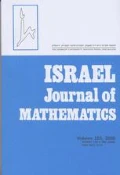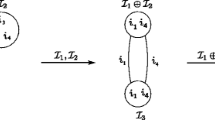Abstract
For a positive integer k, we say that a graph is k-existentially complete if for every 0 ⩽ a ⩽ k, and every tuple of distinct vertices x1, …, xa, y1, …, yk−a, there exists a vertex z that is joined to all of the vertices x1, …, xa and to none of the vertices y1, …, yk−a. While it is easy to show that the binomial random graph Gn,1/2 satisfies this property (with high probability) for k = (1 − o(1)) log2n, little is known about the “triangle-free” version of this problem: does there exist a finite triangle-free graph G with a similar “extension property”? This question was first raised by Cherlin in 1993 and remains open even in the case k = 4.
We show that there are no k-existentially complete triangle-free graphs on n vertices with \(k\, > \,{{8\log \,n} \over {\log \,\log n}}\), for n sufficiently large.
Similar content being viewed by others
References
P. J. Cameron, The random graph, in The Mathematics of Paul Erdős, II, Algorithms and Combinatorics, Vol. 14, Springer, Berlin, 1997, pp. 333–351.
G. L. Cherlin, Combinatorial problems connected with finite homogeneity, in Proceedings of the International Conference on Algebra, Part 3 (Novosibirsk, 1989) Contemporary Mathematics, Vol. 131, American Mathematical Society, providence, RI, 1992, pp. 3–30.
G. L. Cherlin, Two problems on homogeneous structures, revisited, in Model Theoretic Methods in Finite Combinatorics Contemporary Mathematics, Vol. 558, American Mathematical Society, Providence, RI, 2011, pp. 319–416.
R. Diestel, I. Leader, A. Scott and S. Thomassé, Partitions and orientations of the Rado graph, Transactions of the American Mathematical Society 5 (2007) 2395–2405.
P. Erdős and S. Fajtlowicz, Maximum degree in graphs of diameter 2, Networks 1 (1980) 87–90.
P. Erdős and J. Pach, Remarks on stars and independent sets, in Aspects of Topology, London Mathematical Society Lecture Notes Series, Vol. 93, Cambridge University Press, Cambridge, 1985, pp. 307–313.
P. Erdős and G. Szekeres, A combinatorial problem in geometry, Compositio Mathematica 2 (1935) 463–470.
C. Even-Zohar and N. Linial, Triply existentially complete triangle-free graphs, Journal of Graph Theory 78 (2015) 26–35.
C. Ward Henson, A family of countable homogeneous graphs., Pacific Journal of Mathematics 38 (1971) 69–83.
J. Pach, Graphs whose every independent set has a common neighbour, Discrete Mathematics 37 (1981) 217–228.
R. Rado, Universal graphs and universal functions, Acta Arithmetica 9 (1964) 331–340.
F. P. Ramsey, On a problem of formal logic, Proceedings of the London Mathematical Society s2–30 (1930) 264–286.
J. Spencer, The Strange Logic of Random Graphs, Algorithms and Combinatorics, Vol. 22, Springer, Berlin, 2001.
Acknowledgements
We should like to thank Béla Bollobás for introducing us to the problem of Cherlin. The second-named author would like to thank Trinity College Cambridge for support. He would also like to thank the Cambridge Combinatorics group for their hospitality. We should also like to thank the anonymous referee for many thoughtful comments that improved the presentation of this paper.
Author information
Authors and Affiliations
Corresponding author
Rights and permissions
About this article
Cite this article
Letzter, S., Sahasrabudhe, J. On existentially complete triangle-free graphs. Isr. J. Math. 236, 591–601 (2020). https://doi.org/10.1007/s11856-020-1982-3
Received:
Revised:
Published:
Issue Date:
DOI: https://doi.org/10.1007/s11856-020-1982-3




